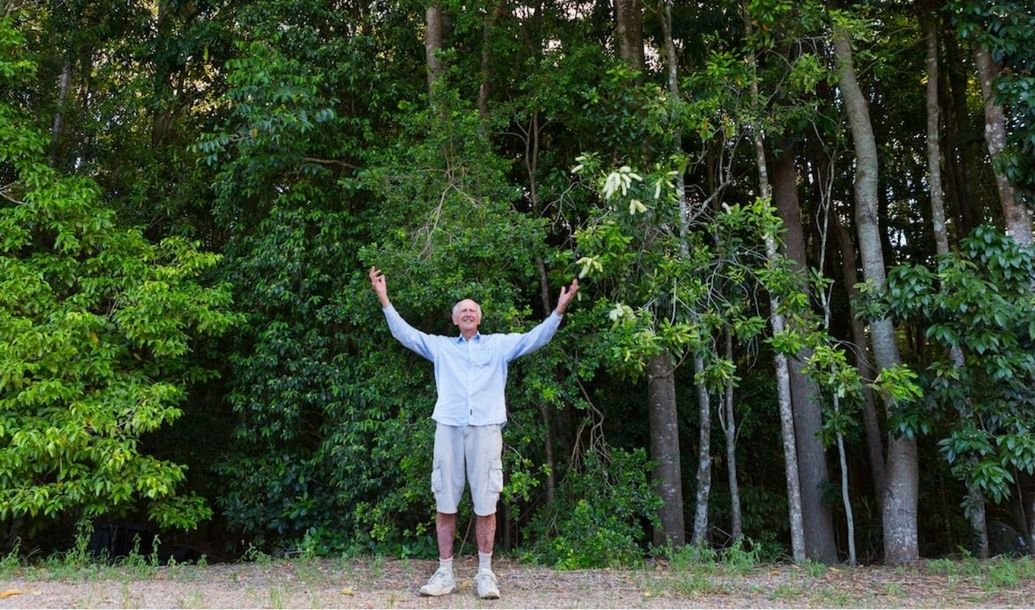A look inside Big Scrub RC Co-Founder, Dr Tony Parkes’, Bangalow rainforest
After hanging up his hat as an investment banker in the ‘80s, Dr Tony Parkes AO and his late wife Rowena began planting rainforest trees on their Bangalow property. The pair, who were 18 and 20 when they met in Tasmania, had spent the better part of a year travelling around Australia, but nothing impressed them more than the beauty of the Big Scrub.
Having lived in Hobart, Sydney, London and Montreal, they settled into their 20-acre parcel of land and picked up their shovels. The property was mostly degraded pasture, but contained patches of camphor laurel and three small remnants of fully mature Big Scrub rainforest.
Early restoration efforts established a 4 ha patch of replanted rainforest, which was later linked to the main remnant in stages and with significant riparian restoration along 4.5km of Skinners Creek running along the boundary of the property.
Today, the Parkes family’s work manifests in the form of 14ha of stunningly biodiverse rainforest, which through trials incorporated in the plantings helped Big Scrub Rainforest Conservancy determine the most effective tree spacing and ground treatment in Big Scrub restoration plantings.
With over 180 indigenous species planted on “TARRA”, named from the acronym of his wife’s and children’s names, its biodiversity is higher than the usual 120-150 species contained in naturally occurring stands of local rainforest.
Now the initially-planted area is 30 years old, it is evolving towards the structure of an old-growth remnant, with a few key differences. Most of the pioneer species have been shaded out and replaced, but the canopy still comprises many secondary species – faster growing but less long lived than the mature-phase species which make up 90% of an old-growth canopy. There are also less vines and epiphytes (planting these would add hundreds of extra species to the list), but these are slowly marching from the remnants into the restored sections.
At 92, Tony still works full time in his role as Founder and President of Big Scrub Rainforest Conservancy. He names the Big Scrub’s beauty and biodiversity, and the hope of saving it from extinction, as the force that drives him to achieve more. In his 25 years of service to conservation, Tony has been recognised with multiple NSW Landcarer and Landcare Group awards, the prestigious Australian Minister for the Environment’s Banksia Award for Community Conservation Leadership and an Order of Australia.
Nowadays his attention is firmly focussed on a new project which is applying DNA sequencing and genome analysis to establishing a plantation to provide seed of 60 key structural and threatened Big Scrub species with optimal genetic diversity to avoid inbreeding and withstand climate change, pests and disease. The world-first project is conducted in partnership with the Royal Botanic Gardens of Sydney and a number of other partners and supporters, including the NSW Government. The purpose of the project is to save from extinction the Big Scrub’s critically endangered lowland subtropical rainforest and 30 of its threatened species. This innovative approach can be applied world-wide to the restoration and recovery of other degraded forest ecosystems.
Our Science Saving Rainforests project is solving a problem we were aware of but weren’t able to solve 25 years ago, Tony says. “The huge reduction in the cost of DNA sequencing has enabled this breakthrough. We are now collecting leaf samples for DNA sequencing from up to 200 individual trees across the whole range of 60 species. The latest genome analysis software developed by our partner the Royal Botanic Gardens Sydney will enable selection of up to 20 individual trees of each species from which we will propagate planting stock for the plantation that will produce seed with optimal genetic diversity for use in restoration and recovery plantings.
Tony credits the support of his wife, who worked alongside him into her later years, for making much of what he achieved possible. When asked to speak of his love of the Big Scrub, he can’t do so without tribute to Rowena.
“In my 50s I quit full time work to spend more time with Rowena. The beauty and diversity of the rainforest is what captured us. If you compare it to walking through the dry bushland where I grew up, it’s like you’re on a different planet. I fell in love with it and still am. It’s the second great love affair of my life.”






